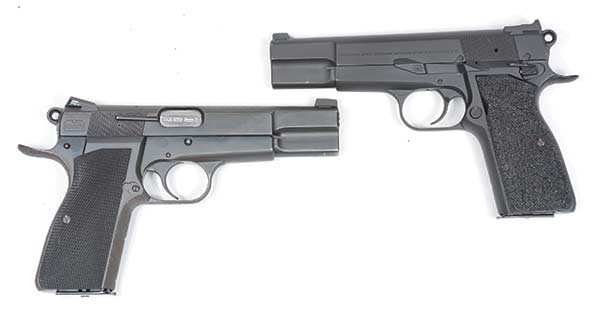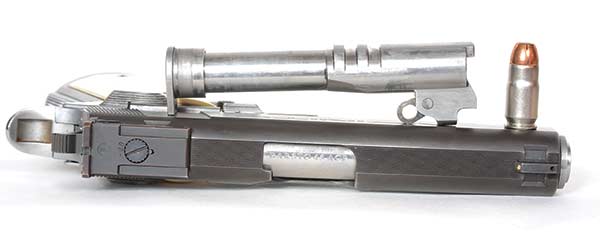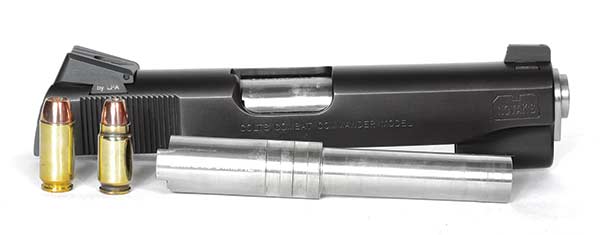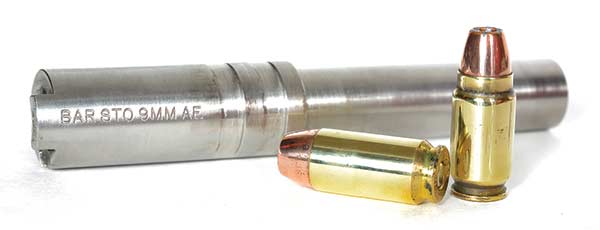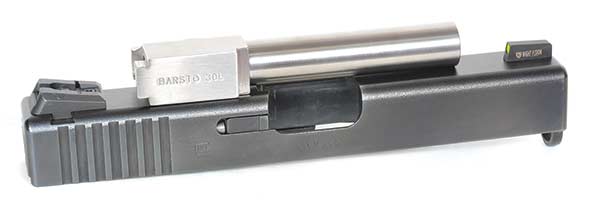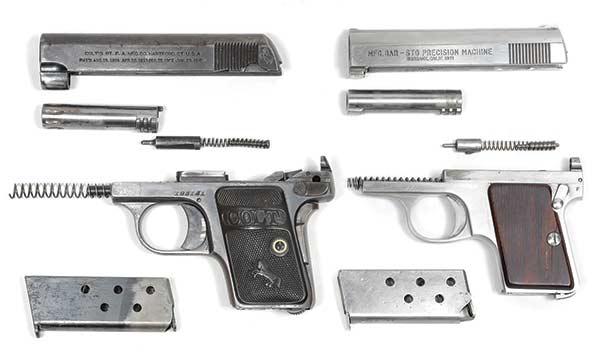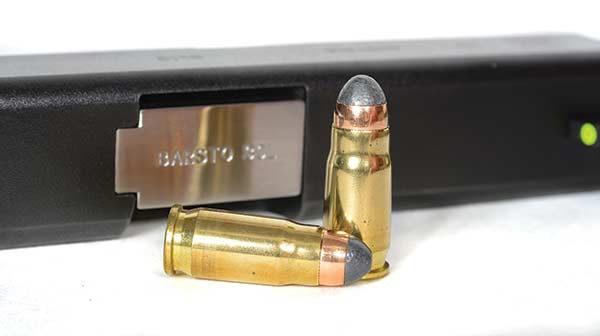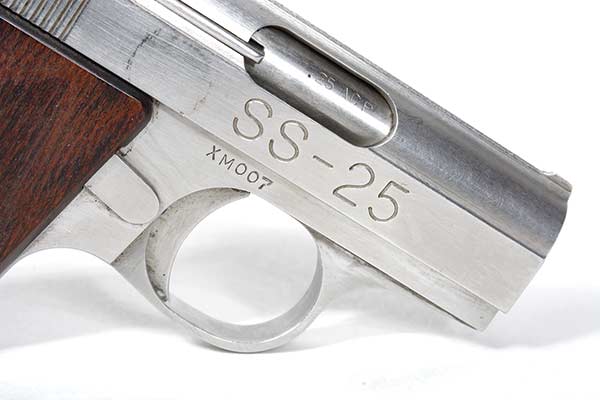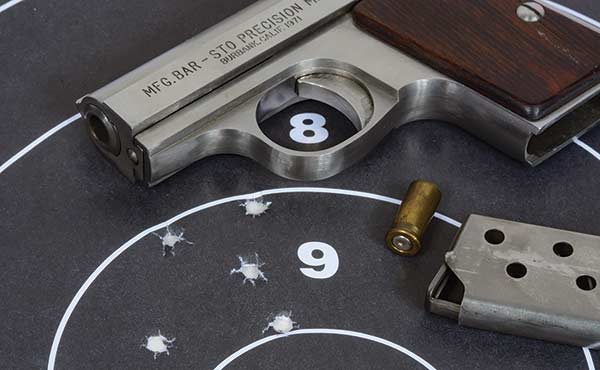Bottle Rockets
Bar-Sto Barrels in Bottleneck Calibers
These custom Hi-Powers have Bar-Sto barrels: The one on the left was built at Novak’s, which also built the FBI HRT Hi-Powers. The pistol on the right was built by Daniel Batchelor of Powder River Precision, who was taught at Bar-Sto.
Origin Story
Named in the late ’60s after founder Irv Stone’s wife, Barbara (Bar-Sto, get it?), the company’s genesis came much earlier. A tool-and-die maker, Stone had done some rifle ’smithing in Detroit in the 1940s. After WWII, he began shooting with Col. Jeff Cooper, whose groundbreaking Leatherslap events were then taking place in Big Bear, Calif. Those events are the origin of practical pistol competition and led to the founding of IPSC; they also placed new demands on the 1911 just coming into its prime.
Decades of matches later, we take oversized match barrels for granted, but there weren’t any in those days. For those needing an accurate .45, there was a whole galaxy of modifications from welding up the barrel hoods and lower lugs to silver-brazing fitting pads inside or on top of the slide. Stone’s idea of simply making the barrels oversized so they could be fitted down to the gun helpfully came at a time when he had access to extremely good material.
As an experimental machine shop, Irv would produce one-off parts, including parts for the Apollo moon rocket. One of these was a hydraulic cylinder made by a trepanning process that resulted in a large cylinder of scrap steel. Needless to say, it was excellent steel. It provided the material for his first fifty 1911 barrels, which sold for $25 each, postage included. The first 1911 barrels were made around 1967, followed by barrels for Browning Hi-Powers, then CZ and S&W, Beretta, SIG, GLOCK, XDs and more. Fast-forward over 40 years, and Bar-Sto remains a family business in the capable hands of Irv Stone III and his wife, Lisa.
Accuracy
As a barrel maker should, Bar-Sto has a reputation for accuracy. My daily carry gun is a Novak Colt with a Bar-Sto fit to it, and from the Ransom Rest, it shot JHP and ball into 1.5″ at 25 yards. That’s on average: Some do better and who knows what match ammo would do. The most accurate 1911 I’ve tested was a pistol with a Bar-Sto barrel built by current American Pistolsmiths Guild President Daniel Batchelor, who was taught at Bar-Sto. It averaged a shocking 1.1″ at 25 yards with ball and defensive ammo. And it never malfunctioned, either.
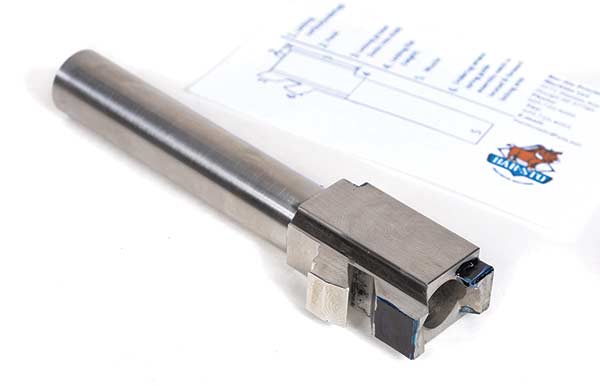
Bar-Sto’s GLOCK barrels come with a diagram and fitting instructions,
which must be followed carefully. Even if you’ve fit other barrels before,
the process is different. Fitting it as you would a 1911, for example, will
dangerously change the headspace. The blue is Dykem marking fluid
placed on some of the fitting points.
Caliber Games
Now for the calibers. Inspiration sometimes results from irritation, and so it was with the .41 Avenger, a formidable self-defense caliber with a name that really wouldn’t go over well if it had to be used. Created by Contender and wildcat wizard J.D. Jones, the idea of necking down the .45 ACP to shoot a .41 revolver bullet was mentioned in print by Col. Jeff Cooper, who, Jones said, expressed the thought with some criticism that gunsmiths of the day couldn’t do it. Appropriately instigated, Jones shot the first one the same afternoon after reading the article.
It really was a stroke of brilliance since it could be fired from a 1911 with a simple barrel change. Loading ammo was easy and required just a little extra “oomph” on the press handle when forming the bottleneck in the case. Ballistics were impressive, with a 210-grain slug charging out at some 1,000 fps — close to the traditional 230-grain weight of the .45, but with more velocity and higher sectional density. Think warm .45 ACP, but with greater penetration.
When I decided my life wouldn’t be complete without an Avenger (even though it was many years after it had passed from prominence), Bar-Sto kindly pulled out its old rifling broach and made a ramped one for a custom Officer’s/Commander hybrid I was building, complete with correct chamber markings. It joined two other Bar-Sto barrels already fitted to the gun in .45 ACP and .38 Super. While I did a fair amount of load development for the .41 and got substantially more power out of it, I settled on a 900-fps load that was comfortable to shoot but still stout. Others went further in this direction during the Avenger’s heyday, shooting “collar button” sized bullets with less recoil, but I still like the 210.
Neck Up, Neck Down
In the ongoing challenge to make 9mm pistols better stoppers, Evan Whildin of Action Arms found a relatively simple solution in 1986: Make them chamber a more powerful cartridge. His .41 Action Express (remember, this is before the .40) fired a 200-grain bullet at 1,000 fps out of a cartridge with a rebated case head the same size as a 9mm, which means only a barrel and magazine swap are required to shoot it in a nine. Reasonable in a 1911 but vicious in a Hi-Power, it was a substantial step up in power. Having necked a 9mm up to .41 in 1988, Whildin then necked it back down, creating a bottleneck 9mm cartridge with the same rebated rim.
9mm Action Express
Around this time, Wiley Clapp had a 9mm Commander top end built for both calibers by pistolsmith Wayne Novak, with twin Bar-Sto barrels fitted by Irv Stone. Some 15 years later, the assembly came to me.
If the .41 was stout — and it was — the 9mm AE was savage. When I loaded for it, I managed to clock a 115-grain jacketed hollowpoint at 1,500 fps out of that 4 1⁄4″ Bar-Sto barrel, but apparently, I ran out of courage. Factory data managed a shocking 1,800 fps for that bullet weight, and gun writer Dean Grennell got results he was too afraid to publish. The performance I saw was beyond most published load data for .357 SIG, the 9AE’s spiritual successor, and deep into .357 Magnum territory; factory velocity is well beyond this.
.30 Luger
The third bottleneck, with which I have less experience, is the .30 Luger — basically a .30 Mauser cartridge reduced slightly in power and shortened to fit in what would become the Luger pistol. Later, the bottleneck walls were ironed out to create the tapered case and larger bullet known as the 9mm Luger.
The .30 does not offer the substantial increase in performance of the .41 Avenger or 9AE. Still, it is (a) undeniably cool and (b) a second caliber option for common pistols when 9mm ammo is in short supply, as it has been for two years now. Unlike the AE twins, it requires a barrel swap and perhaps a change in recoil spring, but doesn’t need different magazines. Bar-Sto supplied one for a GLOCK 19, and it dropped into my 3rd Generation 19, which is unmodified except for the addition of Novak night sights. It comes with instructions for those guns that may require some minor fitting. The process is substantially different from barrels like the 1911, so heed them closely. Like all Bar-Sto barrels, it’s made from 416 stainless steel.
The .30 Luger generally sends a 93- or 100-grain FMJ bullet out into the world at 1,100 or 1,200 fps and is not known as a stopper. Cartridges of the World describes it as adequate for rabbits with correct shot placement, telling us most of what we need to know. It would not cycle the recoil system in my GLOCK, at its best with 124-grain +P, so I replaced it with an aftermarket 13-lb. spring, which I expect to do better. The ammo can be inconsistent, so your mileage may vary, but at the beginning of “Ammogeddon,” .30 was still readily available at reasonable prices, making it an attractive option for practice. It’s pricier now, but it can be found.
Barrels and More
Barrels are not all Bar-Sto does; they produce some fine 1911s and made a unique stainless steel pocket pistol early on. A riff on the Colt 1908 Vest Pocket mechanism but smaller, the .25s were introduced around 1971, with some 104 or 105 pistols being completed before barrel demand overwhelmed the ability to keep producing it. Irv Stone III was kind enough to lend me serial number 007, the one his father made for his mother. Finished in brushed stainless, the jewel-like pistol is an impressive piece of engineering, especially considering all the parts were handmade on a manual machine. It also shoots: Even with the tiny sights, I managed to put five rounds in a little over 1 ¾” at 7 yards. I shouldn’t have been surprised at the accuracy: Bar-Sto is, of course, the first custom barrel shop.
For more info: BarSto.com, Brownells.com

